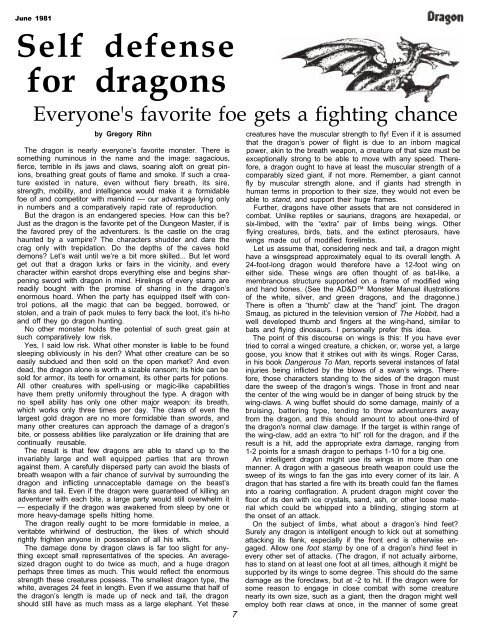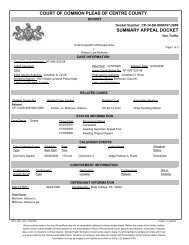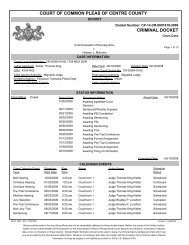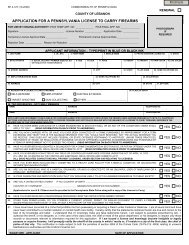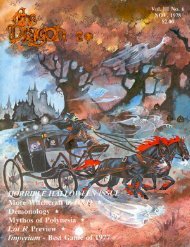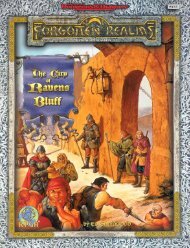Dragon Magazine #050.pdf - TheCrimsonPirate.com
Dragon Magazine #050.pdf - TheCrimsonPirate.com
Dragon Magazine #050.pdf - TheCrimsonPirate.com
Create successful ePaper yourself
Turn your PDF publications into a flip-book with our unique Google optimized e-Paper software.
June 1981<br />
Self defense<br />
for dragons<br />
Everyone's favorite foe gets a fighting chance<br />
by Gregory Rihn<br />
The dragon is nearly everyone’s favorite monster. There is<br />
something numinous in the name and the image: sagacious,<br />
fierce, terrible in ifs jaws and claws, soaring aloft on great pinions,<br />
breathing great gouts of flame and smoke. If such a creature<br />
existed in nature, even without fiery breath, its sire,<br />
strength, mobility, and intelligence would make it a formidable<br />
foe of and <strong>com</strong>petitor with mankind — our advantage lying only<br />
in numbers and a <strong>com</strong>paratively rapid rate of reproduction.<br />
But the dragon is an endangered species. How can this be?<br />
Just as the dragon is the favorite pet of the Dungeon Master, if is<br />
the favored prey of the adventurers. Is the castle on the crag<br />
haunted by a vampire? The characters shudder and dare the<br />
crag only with trepidation. Do the depths of the caves hold<br />
demons? Let’s wait until we’re a bit more skilled... But let word<br />
get out that a dragon lurks or fairs in the vicinity, and every<br />
character within earshot drops everything else and begins sharpening<br />
sword with dragon in mind. Hirelings of every stamp are<br />
readily bought with the promise of sharing in the dragon’s<br />
enormous hoard. When the party has equipped itself with control<br />
potions, all the magic that can be begged, borrowed, or<br />
stolen, and a train of pack mules to ferry back the loot, it’s hi-ho<br />
and off they go dragon hunting.<br />
No other monster holds the potential of such great gain at<br />
such <strong>com</strong>paratively low risk.<br />
Yes, I said low risk. What other monster is liable to be found<br />
sleeping obliviously in his den? What other creature can be so<br />
easily subdued and then sold on the open market? And even<br />
dead, the dragon alone is worth a sizable ransom; its hide can be<br />
sold for armor, its teeth for ornament, its other parts for potions.<br />
All other creatures with spell-using or magic-like capabilities<br />
have them pretty uniformly throughout the type. A dragon with<br />
no spell ability has only one other major weapon: its breath,<br />
which works only three times per day. The claws of even the<br />
largest gold dragon are no more formidable than swords, and<br />
many other creatures can approach the damage of a dragon’s<br />
bite, or possess abilities Iike paralyzation or life draining that are<br />
continually reusable.<br />
The result is that few dragons are able to stand up to the<br />
invariably large and well equipped parties that are thrown<br />
against them. A carefully dispersed party can avoid the blasts of<br />
breath weapon with a fair chance of survival by surrounding the<br />
dragon and inflicting unnacceptable damage on the beast’s<br />
flanks and tail. Even if the dragon were guaranteed of killing an<br />
adventurer with each bite, a large party would still overwhelm it<br />
— especially if the dragon was awakened from sleep by one or<br />
more heavy-damage spells hitting home.<br />
The dragon really ought to be more formidable in melee, a<br />
veritabte whirlwind of destruction, the likes of which should<br />
rightly frighten anyone in possession of all his wits.<br />
The damage done by dragon claws is far too slight for anything<br />
except small representatives of the species. An averagesized<br />
dragon ought to do twice as much, and a huge dragon<br />
perhaps three times as much. This would reflect the enormous<br />
strength these creatures possess. The smallest dragon type, the<br />
white, averages 24 feet in length. Even if we assume that half of<br />
the dragon’s length is made up of neck and tail, the dragon<br />
should still have as much mass as a large elephant. Yet these<br />
7<br />
creatures have the muscular strength to fly! Even if it is assumed<br />
that the dragon’s power of flight is due to an inborn magical<br />
power, akin to the breath weapon, a creature of that size must be<br />
exceptionally strong to be able to move with any speed. Therefore,<br />
a dragon ought to have at least the muscular strength of a<br />
<strong>com</strong>parably sized giant, if not more. Remember, a giant cannot<br />
fly by muscular strength alone, and if giants had strength in<br />
human terms in proportion to their size, they would not even be<br />
able to stand, and support their huge frames.<br />
Further, dragons have other assets that are not considered in<br />
<strong>com</strong>bat. Unlike reptiles or saurians, dragons are hexapedal, or<br />
six-limbed, with the “extra” pair of limbs being wings. Other<br />
flying creatures, birds, bats, and the extinct pterosaurs, have<br />
wings made out of modified forelimbs.<br />
Let us assume that, considering neck and tail, a dragon might<br />
have a winsgspread approximately equal to its overall length. A<br />
24-foot-long dragon would therefore have a 12-foot wing on<br />
either side. These wings are often thought of as bat-like, a<br />
membranous structure supported on a frame of modified wing<br />
and hand bones. (See the AD&D Monster Manual illustrations<br />
of the white, silver, and green dragons, and the dragonne.)<br />
There is often a “thumb” claw at the “hand” joint. The dragon<br />
Smaug, as pictured in the television version of The Hobbit, had a<br />
weIl developed thumb and fingers at the wing-hand, similar to<br />
bats and flying dinosaurs. I personally prefer this idea.<br />
The point of this discourse on wings is this: If you have ever<br />
tried to corral a winged creature, a chicken, or, worse yet, a large<br />
goose, you know that it strikes out with its wings. Roger Caras,<br />
in his book Dangerous To Man, reports several instances of fatal<br />
injuries being inflicted by the blows of a swan’s wings. Therefore,<br />
those characters standing to the sides of the dragon must<br />
dare the sweep of the dragon’s wings. Those in front and near<br />
the center of the wing would be in danger of being struck by the<br />
wing-claws. A wing buffet should do some damage, mainly of a<br />
bruising, battering type, tending to throw adventurers away<br />
from the dragon, and this should amount to about one-third of<br />
the dragon's normal claw damage. If the target is within range of<br />
the wing-claw, add an extra “to hit” roll for the dragon, and if the<br />
result is a hit, add the appropriate extra damage, ranging from<br />
1-2 points for a smash dragon to perhaps 1-10 for a big one.<br />
An intelligent dragon might use its wings in more than one<br />
manner. A dragon with a gaseous breath weapon could use the<br />
sweep of its wings to fan the gas into every corner of its lair. A<br />
dragon that has started a fire with its breath could fan the flames<br />
into a roaring conflagration. A prudent dragon might cover the<br />
floor of its den with ice crystals, sand, ash, or other loose material<br />
which could be whipped into a blinding, stinging storm at<br />
the onset of an attack.<br />
On the subject of limbs, what about a dragon’s hind feet?<br />
Surely any dragon is intelligent enough to kick out at something<br />
attacking its flank, especially if the front end is otherwise engaged.<br />
Allow one foot stamp by one of a dragon’s hind feet in<br />
every other set of attacks. (The dragon, if not actually airborne,<br />
has to stand on at least one foot at all times, although it might be<br />
supported by its wings to some degree. This should do the same<br />
damage as the foreclaws, but at -2 to hit. If the dragon were for<br />
some reason to engage in close <strong>com</strong>bat with some creature<br />
nearly its own size, such as a giant, then the dragon might well<br />
employ both rear claws at once, in the manner of some great


